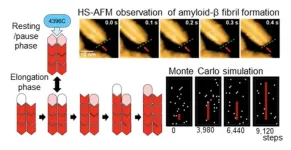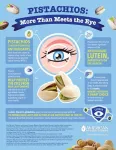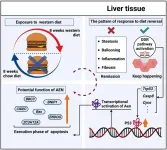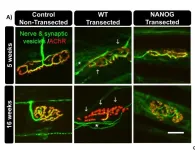Take aim at the pause!
New insights into amyloid β fibril growth offer hope for halting Alzheimer's progression
2024-10-24
(Press-News.org)
A collaborative research group, including researchers from Exploratory Research Center on Life and Living Systems and Institute for Molecular Science of National Institutes of Natural Sciences, as well as Nagoya City University, Nagoya University, and University of Tsukuba, has uncovered a new mechanism in the growth of amyloid β (Aβ) fibrils, which are closely associated with Alzheimer’s disease. Using advanced high-speed atomic force microscopy (HS-AFM), the team was able to observe Aβ fibril growth at the molecular level in real time. This breakthrough sheds new light on how these fibrils grow and how their progression can be effectively halted.
Alzheimer’s disease is a serious neurodegenerative disorder that leads to cognitive decline and memory loss. One of the main contributors to the disease is the accumulation of Aβ proteins in the brain, which clump together to form fibrils. These fibrils interfere with brain function, and understanding how they grow and can be stopped is essential for developing new treatments. However, the exact growth mechanisms of Aβ fibrils and ways to halt them have remained unclear—until now.
The researchers found that each Aβ fibril is composed of two thin strands, called protofilaments. These protofilaments grow in an alternating pattern, with individual Aβ molecules adding to the ends of each strand one at a time. A critical finding of the study was that when the ends of these two protofilaments align, the fibril enters a "paused state," where growth temporarily stops. This pause in growth is a crucial step in the Aβ fibril formation process and could be key to understanding how Alzheimer’s disease progresses.
One of the most notable discoveries was the role of an antibody, 4396C, which selectively binds to the ends of the Aβ fibrils during this paused state. Once the antibody binds, the fibril is locked in this state, and further growth is prevented. This finding reveals a promising new approach to stopping Aβ fibril growth and, potentially, slowing the progression of Alzheimer’s disease.
The detailed high-resolution observations made with HS-AFM allowed the research team to uncover this alternating growth and pause mechanism, which had not been previously identified. By targeting the paused state of Aβ fibrils, this study opens up new possibilities for developing treatments that can delay or halt Alzheimer’s disease at the molecular level.
In the future, the team plans to further investigate the action of the 4396C antibody, with the hope of applying these findings to create new therapeutic approaches for Alzheimer’s disease. Additionally, the discovery may have broader implications for other amyloid-related diseases, as the insights gained from this study could inform treatments for a range of conditions involving protein aggregation.
END
[Attachments] See images for this press release:


ELSE PRESS RELEASES FROM THIS DATE:
2024-10-24
A new study1 from researchers at the Friedman School of Nutrition Science and Policy at Tufts University has found that consuming pistachios daily may significantly improve eye health by increasing macular pigment optical density (MPOD), due to the plant pigment lutein, a key factor in protecting the eyes from blue (visible) light and age-related damage.
The randomized controlled trial showed that compared to eating a usual diet alone, eating 2 ounces (57 grams) of pistachios per day for 12 weeks as part of a usual diet resulted in a significant increase in MPOD in otherwise healthy middle-aged to older adults. MPOD is an important indicator of eye health, ...
2024-10-24
Background and Aims
Metabolic dysfunction-associated steatotic liver disease (MASLD) and its more advanced form, metabolic dysfunction-associated steatohepatitis, have emerged as the most prevalent liver diseases worldwide. Currently, lifestyle modification is the foremost guideline-recommended management strategy for MASLD. However, it remains unclear which detrimental signals persist in MASLD even after disease remission. Thus, we aimed to examine the persistent changes in liver transcriptomic profiles following ...
2024-10-24
ECOG-ACRIN Cancer Research Group (ECOG-ACRIN) and Caris Life Sciences®(Caris) announced today a multi-year research collaboration wherein Caris is pairing its highly sophisticated and comprehensive genomic, transcriptomic and proteomic profiling, advanced artificial intelligence (AI) and machine learning algorithms with ECOG-ACRIN’s immense research capabilities. The first project is underway and leverages the tumor tissue samples from the Trial Assigning Individualized Options for Treatment (Rx) or TAILORx, breast cancer clinical trial. TAILORx is one of the world's largest breast cancer research resources. The TAILORx trial and its associated biospecimen ...
2024-10-24
Self-assembling molecules into organized structures is highly valuable for developing new materials. One notable class of these materials is lyotropic chromonic liquid crystals (LCLCs), which are molecular assemblies of amphiphilic π-electronic molecules, with water-absorbing and water-repelling parts. The term “lyotropic” refers to liquid crystal phases that depend on the concentration of the molecules in a solvent, while “chromonic” indicates that these molecules are stacked into columnar assemblies. In a solvent, these structures are stabilized by π–π interactions and hydrophobic effects. Examples of ...
2024-10-24
CLEVELAND—Researchers at the Case Western Reserve School of Medicine have found that, when compared to seven other anti-diabetic drugs, semaglutide, a popular diabetes and weight-loss drug, may lower the risk of Alzheimer’s disease in people with type 2 diabetes (T2D).
Alzheimer’s disease is a brain disorder that slowly destroys memory and thinking skills. According to the Alzheimer’s Association, nearly 7 million Americans 65 and older are living with the disease, and there are more deaths from Alzheimer’s than breast and prostate cancer combined.
The study, published ...
2024-10-24
A UNC Greensboro (UNCG) study following 299 women and their infants from pregnancy to toddlerhood examined mul ple psychological, biological, and social factors in the context of infants’ rapid weight gain. They found infant feeding practices associated with obesity, known as obesogenic practices, are strongly correlated with rapid infant weight gain.
Examples of obesogenic practices described in their recent Pediatric Obesity paper include watching television while feeding a baby, formula feeding, and supplementing a bottle with additional foods.
“The key take ...
2024-10-24
Scientists from Cleveland Clinic and Cornell University have designed a publicly-available software and web database to break down barriers to identifying key protein-protein interactions to treat with medication.
The computational tool is called PIONEER (Protein-protein InteractiOn iNtErfacE pRediction). Researchers demonstrated PIONEER’s utility by identifying potential drug targets for dozens of cancers and other complex diseases in a recently published Nature Biotechnology article.
Genomic research is key in drug discovery, but it is not always enough on its own, says Feixiong Cheng, PhD, study co-lead author and director of Cleveland Clinic’s Genome Center. When ...
2024-10-24
BUFFALO, N.Y. — The key to recovering from traumatic nerve injuries, like those sustained in motor vehicle accidents or gunshot wounds, may be a gene named for the land of everlasting youth in Irish folklore.
In a study published today (Oct. 24) in Nature Communications, a University at Buffalo-led research team describes how the gene, called NANOG, can improve the regrowth of damaged nerves and re-establish innervation (the process of nerves growing and connecting with organs or tissues) after traumatic severing of peripheral nerves.
The gene’s name is derived from Tír na nÓg, which is a mythical ...
2024-10-24
If a phone or other electronic device was made of soft materials, how would that change its use? Would it be more durable? If hospital health monitoring equipment was made of less rigid components, would it make it easier for patients to wear?
While electronics of that type may still be far in the future, Virginia Tech researchers have developed an innovative method for constructing the soft electronic components that make them up. The focus of a project from the team of Michael Bartlett, principal investigator and associate professor in the Department of Mechanical Engineering, ...
2024-10-24
A study published today in IOP Publishing’s journal Environmental Research Letters, has revealed a staggering $79 billion in annual climate-related costs from the production of common materials in the United States. These costs, which stem from greenhouse gas emissions, are not reflected in current market prices, effectively creating a massive subsidy for carbon-intensive industries.
“High price point is a common reason why low emission alternative materials are not adopted voluntarily by industries. Accounting for the externalized cost of emissions could provide an economic basis for driving innovation and implementation of alternative material production ...
LAST 30 PRESS RELEASES:
[Press-News.org] Take aim at the pause!
New insights into amyloid β fibril growth offer hope for halting Alzheimer's progression









